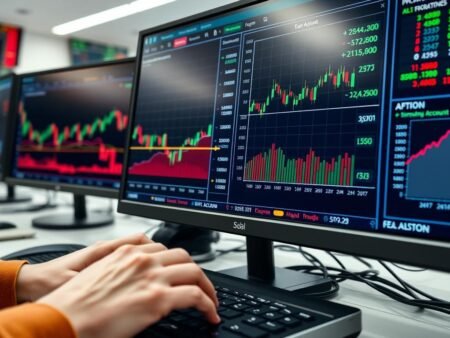Does the mystique of Wall Street still hide the truth of modern trading? Today, investing seems easy with just a smartphone and an app. It’s important to understand the difference between proprietary trading firms and traditional retail trading. This article will explore how each works, the risks they face, and their trading performance.
Proprietary trading firms were once key to financial markets. They brought new strategies to the table. On the other hand, retail traders have grown in number, thanks to better access to markets and info. But what sets prop firm traders apart from retail traders?
We’ll look at everything, from the start, comparing proprietary trading firms to retail trading. We’ll examine the chances each offers, the risks, and what results traders can expect.
Key Takeaways
- Understanding the unique structure and risk protocols of proprietary trading firms versus the autonomy of retail traders.
- Exploring operational differences impacting trading performance and profitability in both trading dimensions.
- Comparing capital requirements, access to advanced trading tools, and educational support available to traders in both realms.
- Assessing risk management strategies adopted by prop firms and how they differ from an individual retail trader’s approach.
- Evaluating the potential financial and lifestyle implications for traders deciding between a professional firm or a go-it-alone retail trading venture.
Understanding Proprietary Trading Firms
Proprietary trading firms, or prop firms, use their own money to make profits. They don’t rely on money from clients. This makes them unique because they take the risk and get the rewards from their trading.
They use funded trader programs and institutional trading resources to succeed. These tools are key to their business.
What Are Proprietary Trading Firms?
Proprietary trading firms trade with their own money, not money from clients. This lets them be more flexible with their strategies and managing risks. They can handle profits and losses on their own.
These firms also trade on a large scale, using market movements to their advantage. This is something individual traders can’t do.
How Prop Firms Operate
These firms use advanced technology and research to make their trading decisions. They have complex algorithms and models that help them stay ahead in the market.
Funded trader programs are a big part of what they do. They let new traders join without needing their own money.
Different Models of Proprietary Trading Firms
Proprietary trading firms come in many shapes and sizes. Some focus on quick trades in liquid assets. Others take a longer view, holding onto investments for a while.
Many firms are starting to use funded trader programs. This makes it easier for new traders to get involved. It helps firms grow and develop skilled traders.
The Anatomy of Traditional Retail Trading
In the world of financial markets, retail trading is key. It lets individual investors join global markets. This area covers the basics and tools for retail traders to play a part, focusing on their strategies, managing money, and choosing platforms.
Retail Traders Explained
Retail traders are individuals who trade with their own money, not for a big company. They vary from newbies to seasoned investors. They use many strategies to make money from the market. Even with less money than big traders, their quick thinking and varied plans help them engage well.
Common Retail Trading Platforms
Retail traders use many platforms to analyze and trade. These platforms are made for them, with easy-to-use interfaces, live data, and tools for charts. They also give access to many markets. Here’s a look at some top platforms for retail traders:
| Platform | User Interface | Toolset | Accessibility |
|---|---|---|---|
| Platform A | Intuitive | Advanced Charting | High |
| Platform B | Simple | Basic Analytics | Medium |
| Platform C | Complex | Comprehensive Tools | High |
The table shows different platforms for different traders. Platform A is great for complex strategies with its easy-to-use interface and detailed charts. Platform B is simpler and easier to get into for new traders. These platforms help traders manage their money and carry out their plans well.
Insights into Funded Trader Programs
Funded trader programs are special offers from proprietary trading firms. They aim to find and grow trading talent. These programs test traders’ skills and help them improve under real market conditions.
At the heart of these programs is a detailed evaluation. Traders must manage a simulated account and meet certain performance goals. This stage is both a filter and a training ground, preparing traders for the real financial markets.
After passing the evaluation, traders get to use the firm’s capital. It’s important for them to match their trading strategies with the firm’s risk rules. This balance is key to making the most profit while keeping risks low.
The focus of these programs is on managing risks and making profits. Traders must be good at picking trades and handling potential losses.
| Program Feature | Description | Benefits |
|---|---|---|
| Evaluation Phase | Simulation of trading to assess skills. | Filters out the top-performing traders. |
| Capital Allocation | Access to firm’s proprietary funds for trading. | Enables high-potential trades without personal financial risk. |
| Performance Benchmarks | Specific targets set for traders’ strategies and results. | Encourages consistent and discipline-based trading. |
| Risk Management | Stringent guidelines to minimize losses. | Protects the firm’s capital while fostering responsible trading habits. |
This setup helps grow skilled traders and meets the goals of proprietary trading firms. By giving real capital, firms invest in promising traders. They expect this environment to produce top traders who will help the firm succeed.
Funded trader programs offer a chance for traders to advance their careers without needing a lot of money. They provide a way to improve skills and earn more financially.
Comparison of Trading Capital Requirements
Trading capital needs differ between proprietary and retail trading. Knowing these differences is key to success. It affects risk management and trading strategies.
Capital Allocation in Prop Firms
Proprietary trading firms give traders capital, making entry easier. This setup lets traders use large sums of money. It can increase their market influence and earnings without personal financial risk.
Initial Investment for Retail Traders
Retail traders fund their accounts themselves. The amount needed varies by platform and asset type. This initial investment is crucial. It affects potential earnings and loss management, essential for trading success.
| Aspect | Proprietary Trading Firm | Retail Trading |
|---|---|---|
| Source of Capital | Firm-funded | Self-funded |
| Initial Investment | None or low | Varies widely |
| Risk Exposure | Managed by firm | Managed by individual |
| Impact on Trading Strategies | High leverage possible | Limited by personal capital |
Risk Management: Prop Firms vs Retail Traders
In trading, risk management is key to protect trading capital. Both proprietary trading firms and individual traders aim to avoid losses and increase profits. Yet, their methods and tools differ a lot.
Risk Protocols in Prop Firms
Proprietary trading firms have strict risk management plans to keep their investment safe. They use advanced models to forecast risks and set trade limits. These steps help keep their capital safe and ensure the firm’s future.
Individual Risk Management for Retail Traders
Retail traders must manage their own risks, setting personal limits and understanding the market. They face a big challenge because they don’t have access to the same tools and strategies that prop firms use.
| Criteria | Proprietary Trading Firms | Retail Traders |
|---|---|---|
| Risk Assessment Tools | Advanced analytics and software | Basic or third-party tools |
| Capital Protection Strategies | Diversified portfolios, imposed limits | Primarily self-imposed stop-losses |
| Dependence on Risk Management | High (Team-based strategies) | High (Personal responsibility) |
Institutional Trading Support vs Self-Taught Approach
The world of trading is split between those who join proprietary trading firms and those who go it alone. This split affects how traders learn and succeed. It shapes their path in the trading world.
Training and Support from Proprietary Trading Firms
Proprietary trading firms have special training programs. They help new traders become skilled. These programs include lots of educational tools, feedback, and mentorship.
With this support, traders learn about different strategies and market trends. This knowledge is key for success in trading.
Learning Curve and Resources for Retail Traders
Retail traders learn on their own. This method is flexible but lacks the support of proprietary firms. They use online resources and forums to learn.
This self-taught path can lead to a unique trading style. But, it might make learning slower and harder.
The choice between these paths greatly impacts trading success. Firms offer strong strategies and a safe trading space. Retail traders grow slower but might feel more accomplished in their learning journey.
Choosing the right trading path depends on personal preferences and how one learns. Traders should weigh their options. Maybe a mix of both learning styles is best for success.
Access to Trading Strategies and Tools
Improving trading performance depends a lot on having good trading strategies and tools. Proprietary trading firms usually have an advantage here. They give their traders many resources, making them stand out from retail traders.
Having these tools and strategies makes trading better. It also helps traders keep doing well over time. A big part of trading in a proprietary firm is using all the tools they have. These tools can really help lower trading costs.
- Real-time analytics and data: Prop firms use fast data and analytics to make better trading choices.
- Algorithmic trading systems: These systems are more common in prop firms. They let traders make money faster.
- Risk management software: Tools that help manage risks better, protecting investments.
Having these tools and strategies helps traders learn and change their strategies often. But, retail traders face a different situation. They use public or less advanced tools. This limits their trading performance and increases their trading costs.
Proprietary trading firms give traders access to top tools and strategies. This helps them trade better and at lower trading costs. On the other hand, retail traders have to choose between spending more or getting better tools.
Understanding the Trading Performance Expectations
Trading firms and individual traders have specific goals that guide their actions. These goals are key to success and making smart trading choices.
Performance Benchmarks for Funded Traders
Funded traders must meet strict targets set by their firms. These targets aim to make money while keeping risk low. The firms provide tools and advice to help traders reach these goals.
Realistic Goals for Retail Traders
Retail traders set their own goals based on their comfort with risk, market knowledge, and capital. These goals are more flexible but can differ a lot. They depend on the trader’s risk management and financial plans.
| Trader Type | Performance Expectations | Focus on Risk Management |
|---|---|---|
| Funded Traders | High, with specific benchmarks | Integral, with firm-imposed protocols |
| Retail Traders | Flexible, self-set goals | Varies, based on individual strategies |
Knowing how goals and risk management affect trading helps all traders. It gives them a clear path to reaching their financial targets.

Trading Costs and Fee Structures
Thinking about a career in trading? It’s key to know about trading costs and fees. These costs affect how much money traders can make. They also shape the decisions traders make in both proprietary firms and as retail traders.
Costs Associated with Proprietary Trading Firms
Proprietary trading firms have their own cost setup. They charge desk fees, tech fees, and a share of trader profits. These fees help cover the firm’s costs, like top-notch trading software and training.
For those interested in trading, it’s important to check these costs. This helps see if they fit with your financial plans and trading style.
Brokerage and Other Fees for Retail Trading
Retail traders face different costs. They pay brokerage fees, transaction costs, and might pay for extra trading tools. These costs change based on the broker, the markets, and how often they trade.
Here’s a side-by-side look at typical costs for traders in proprietary firms versus retail traders:
| Cost Type | Proprietary Trading Firms | Retail Traders |
|---|---|---|
| Desk Fees | Yes | No |
| Technology Fees | Often Included | Optional (depends on platform) |
| Profit Sharing | Yes (varies) | No |
| Brokerage Fees | Lower (due to high volume) | Varies widely |
| Transaction Costs | Lower (bulk discounts) | Standard rates |
Knowing these trading costs helps both proprietary trading firms and retail traders plan better. They can manage their trading finances more effectively.
Pros and Cons of Trading with a Prop Firm
Trading with a proprietary trading firm has its ups and downs. Knowing these can help traders decide if it’s right for them. This is especially true for trading capital and risk management.
- Access to Greater Trading Capital: Prop firms give traders a lot of capital to work with. This is more than most retail traders can get on their own. It lets traders take bigger risks and possibly make more money.
- Structured Risk Management: Prop firms have systems to manage risk. This helps protect both the trader and the firm’s money. It also teaches traders to trade safely and effectively.
- Professional Growth and Mentorship: Many prop firms offer training and mentorship. This helps traders get better and learn new strategies.
- Profit Sharing Model: Traders get to use the firm’s capital but have to give up a part of their earnings. This usually ranges from 50% to 80% of their profits.
- Limited Market Choice: Some prop firms limit the markets or securities traders can trade. This might mean fewer opportunities than trading on their own.
It’s important to weigh both the good and bad points before trading with a prop firm.
| Aspect | Advantages | Disadvantages |
|---|---|---|
| Trading Capital | Higher capital access | Must share profits |
| Risk Management | Structured protocols | Potential over-constraint on trading styles |
| Market Access | Access to multiple markets often with lower fees | May be limited by firm’s policies |
| Professional Development | Mentorship and training available | Dependent on firm’s resources and commitment |
Individual Advantages of Traditional Retail Trading
Traditional retail trading offers unique benefits for those who love finance. It lets traders control their strategies, giving them freedom and direct market access. This setup allows traders to match their plans with their financial goals and risk levels.
Flexibility and Autonomy of Retail Traders
Retail traders value the flexibility this field offers. They can change their strategies quickly, unlike big traders. This quick thinking is key in fast-changing markets, where it can make a big difference.
Being in charge of their trading also helps traders grow. They can build their skills and confidence by making their own decisions.
Direct Market Access and Control
Another big plus is controlling trading costs. Traders can pick affordable platforms and tools for their investments. This direct access lets them make trades fast, giving them an advantage in quick decision-making.
| Feature | Retail Trading |
|---|---|
| Control Over Investments | High – Direct management of assets and costs |
| Flexibility in Trading | High – Ability to quickly adapt strategies |
| Personalization of Strategies | Customizable to trader’s needs and market situations |
Choosing the Right Path: Considerations for Traders
When you’re deciding between proprietary trading firms and being a retail trader, it’s a big choice. You need to know your strengths, goals, and how much risk you can handle.

Assessing Skill Levels and Commitment
It’s important to check your trading skills and how committed you are. Whether you want to work for a proprietary trading firm or trade on your own, knowing your limits is key. This helps match your abilities with the market’s challenges.
Evaluating Financial Goals and Risk Tolerance
Knowing your financial goals and risk level is crucial. Each path, whether with proprietary trading firms or as a retail trader, has its own ups and downs. Understanding your risk tolerance ensures you’re on the right path for success.
| Criteria | Proprietary Trading Firms | Retail Traders |
|---|---|---|
| Skill Requirement | High | Varies |
| Capital Requirement | Low | High |
| Risk Management | Institutional Level | Individual Responsibility |
| Potential Financial Growth | High with Profit Sharing | Depends on Individual Success |
Legal and Regulatory Differences
In finance, knowing about regulatory compliance is key for both trading firms and individual traders. These rules shape how they trade and operate. This part explains how these rules differ, showing their unique landscapes.
Regulation Compliance for Proprietary Trading Firms
Proprietary trading firms face strict rules, more than retail traders. They manage big volumes and can affect markets a lot. They must pass thorough audits, report details, and follow rules from bodies like the SEC and FINRA.
Regulatory Expectations for Retail Traders
Retail traders have to follow rules too, but theirs are less strict. They mainly focus on trading practices, like anti-money laundering and honest customer dealings. Even with less rules, staying compliant is vital for their market standing.
| Aspect | Proprietary Trading Firms | Retail Traders |
|---|---|---|
| Primary Regulatory Bodies | SEC, FINRA | SEC |
| Key Compliance Areas | Audits, Reporting, Operational Conduct | AML, Truthful Disclosures |
| Impact on Operations | High – Requires robust compliance departments | Moderate – Streamlined compliance compared to firms |
| Reporting Requirements | Extensive and frequent | Less frequent, relatively simpler |
So, regulatory compliance greatly affects trading performance for firms and traders. But, it does so in different ways and to different extents.
Prop Firm Trading vs. Traditional Retail Trading: Key Differences
The financial world offers many ways for traders to work in the market. Proprietary trading firms and retail traders are two main paths. Prop firms give traders big trading capital pools, special risk management, training, and a community to support them. Retail traders use their own money, manage their own risks, and often learn on their own.
There’s also a big difference in how traders grow and succeed. Prop firms have clear goals for traders to reach, helping them move up. Retail traders set their own goals and trade at their own speed. They don’t have to follow a firm’s rules but miss out on the resources and support prop firms offer.
In short, prop firms and retail trading differ a lot. They vary in trading capital access, risk management, and support. These differences are key for a trader’s success. Knowing these differences helps traders choose the right path for their style, goals, and risk level.












